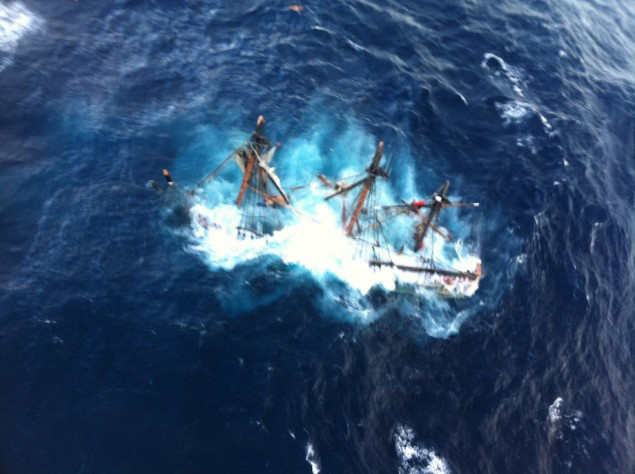From New London, Connecticut . . .
A few days earlier, H.M.S. Bounty II, the ship built in 1960 in connection with a filming of the "Mutiny on the Bounty" story, had sailed south and eastward heading for her home port at St. Petersburg, Florida. Captain Robin Walbridge's plan was to sail Bounty as fast south and eastward as possible so as to avoid the eastern flank of the oncoming mega-storm "Sandy" which was barreling its way northward and would eventually turn westward and slam into the United States along the New Jersey shore.
Staying in constant contact with the National Hurricane Center as they moved southeastward into increasingly rough seas, Bounty's captain and 16-member crew were hoping to beat the odds that the storm would not extend as far to the east as the track they were hoping to sail. They were hoping to make it well around the storm before beginning their run southward to St. Petersburg.
"I think we are going to be into this for several days," Captain Walbridge wrote in a message posted Sunday, October 28, on the Bounty's Facebook site. "We are just going to keep trying to go fast."
But they didn't make it.
The ship's generator failed, causing the bailing pumps to shut down, letting the giant seas the ship was encountering come onboard and not be expelled by the pumps that would have kept the Bounty afloat. Evidently there were no hand-operated pumps aboard, or if there were they were not operated effectively enough to expel the tons of seas that driving into the ship.
As Bounty began filling with water, and listing, calls for help went out to the U.S. Coast Guard station operating in North Carolina. Into stormy, driving-rainstorms a big search plane and rescue helicopters were ordered eastward toward the ship's last reported position some 90 miles south east of Cape Hatteras.
 Above photo by U.S. Coast Guard
Above photo by U.S. Coast Guard
On the ship the crew was ordered into full, foul-weather gear. Then came the order to take to the two big life-rafts Bounty carried. Most made it safely into the rafts. Still, three of the crew members- Captain Walbridge, and Claudene Christian among them- were swept into the ocean. One of the three made it to a life-raft, but Captain Walbridge and Claudene Christian didn't; they were swept away into the seas, away from the rafts and then disappeared.
In answer to the ship's distress signal, the Coast Guard sent a MH-60 Jayhawk helicopter to the ship at about 6:30 a.m., Monday the 29th and lifted five crew members to safety. A second helicopter arrived shortly after and rescued nine people. A C-130 Hercules aircraft and a third Jayhawk continue searching for the two missing crew members.
On Monday afternoon, October 29, airborne Coast Guard crews found the body of Ms. Christian. She was unresponsive when pulled from the water, and didn't revive when taken to the hospital in Elizabeth City, North Carolina. The search for Captain Walbridge continued.
The waters off North Carolina's coast, for a host of environmental factors including sharp winds, shifting currents, hurricanes and a large shoal off shore, make it particularly dangerous for shipping. Its depths hold anywhere from 6,000 to 8,000 shipwrecks, according to Lawrence Babits, professor emeritus and retired director of maritime studies at East Carolina University in Greenville, N.C.
"It is a place where bad things can happen, that's for sure," he said.
By late Wednesday afternoon, October 31, the search for Captain Walbridge continued but until that time it proved fruitless.
Bounty II was a replica of the original Bounty, which in 1789 was the site of a mutiny aboard the ship near Tofoa in the Tongan islands in the South Pacific Ocean. Built in 1960, the 180-foot Bounty II was fully-rigged and armed with four cannons. The ship for many years provided education about maritime life and history at the scores of ports at which it called in the United States, Canada, Europe, North Africa and the Caribbean.
In honor and memory of the sailing crew of HMS Bounty at least two organizations have set up sites at which donations can be made to help rehabilitate the ship's crew members after their ordeal. One, the H.M.S. Bounty Crew Relief Assistance Fund may be found at www.privateerlynx.com/donate. Also, funds may be donated through PayPal.com at HMSBounty2012@yahoo.com.
 Above photo by U.S. Coast Guard
Above photo by U.S. Coast Guard





